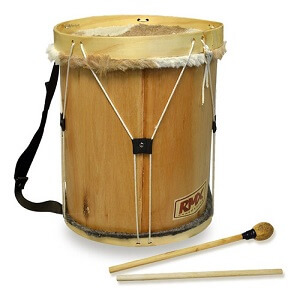Bombo Leguero
 The bombo leguero is an essential element in Argentine folklore. A member of the drum family, this large drum provides a deep and powerful sound which can be heard from a long way away, which accounts for its name which comes from the word leguero-leguas meaning league as in the measurement of distance.
The bombo leguero is an essential element in Argentine folklore. A member of the drum family, this large drum provides a deep and powerful sound which can be heard from a long way away, which accounts for its name which comes from the word leguero-leguas meaning league as in the measurement of distance.
The bombo leguero is a common instrument in Argentine folk traditions such as zamba and chacarera. The body of the drum is made out of a hollowed tree trunk, and the head is made of animal skins.
Originally the large native Argentine drum, as opposed to the present-day bombo leguero, was used, like most percussion instruments, in connection with the social need for musical expression and to accompany religious rituals.
The bombo leguero became popular with the arrival of the Spaniards in around 1516. The military drums of the conquistadors were inspired by the native drum but the sound was altered with the addition of a wooden strap and leather buckles. The bombo leguero or criollo as the Spanish version is known, rapidly gained in popularity, particularly in the North-east of Argentina in areas such as Santiago del Estero, Jujuy and Tucuman.